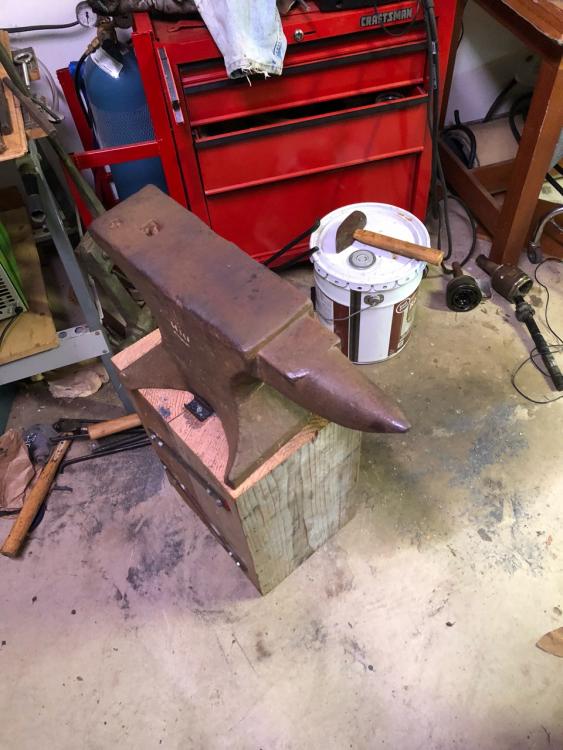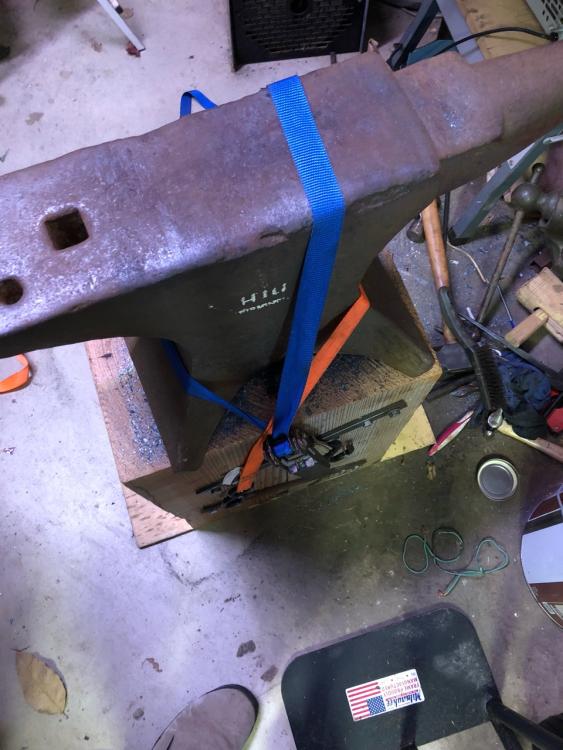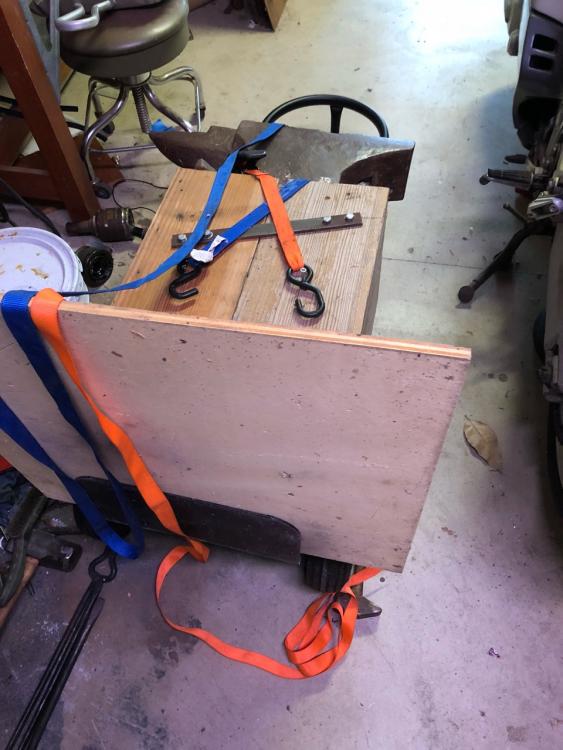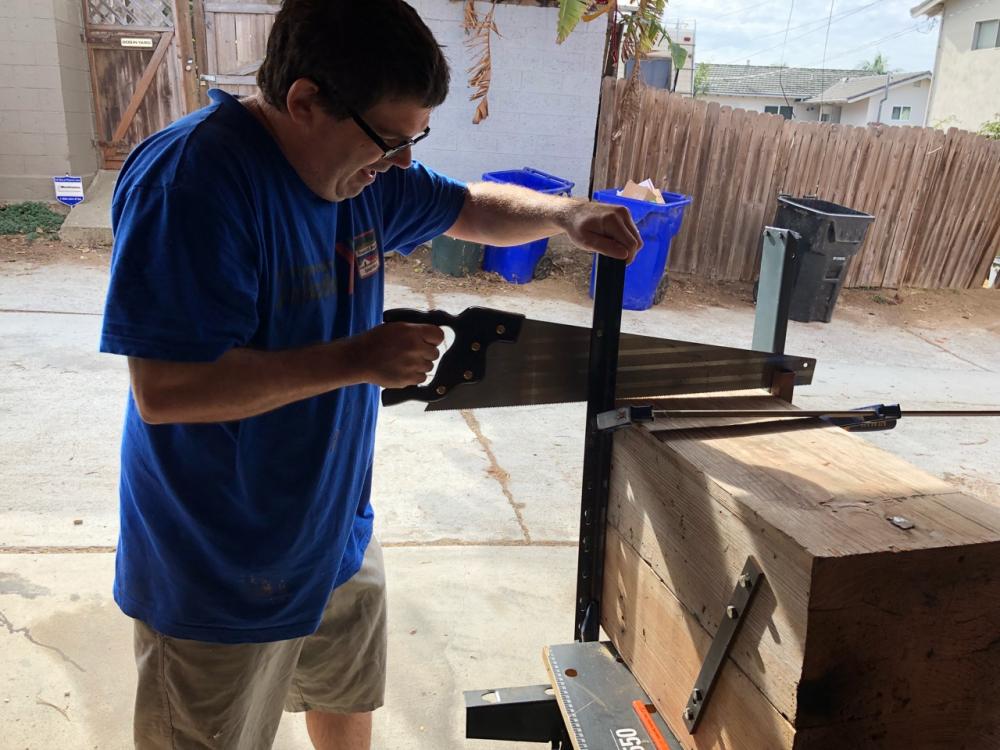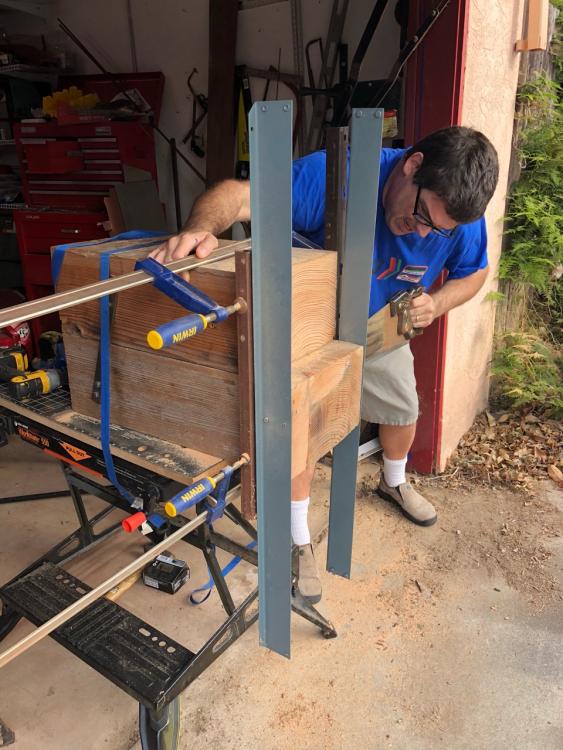
bajajoaquin
Members-
Posts
495 -
Joined
-
Last visited
Content Type
Profiles
Forums
Articles
Gallery
Downloads
Events
Everything posted by bajajoaquin
-
That looks cast to me. It might not repair well using the method for wrought anvils. (I tried to just quote the text of the anvil post above, but I could either get all the pics or nothing at all)
-
Navy Hammer sell off
bajajoaquin replied to jlpservicesinc's topic in Power Hammers, Treadle Hammers, Olivers
My knowledge of steam power is much less than others here, consisting of having spent a few hours helping with the startup procedure and then 10 minutes driving a 1910-ish Moline steam tractor. Having said that, it would not surprise me to find out that the inspection regimen is less onerous and spectacular than described for steam cleaning and thawing equipment. The boilers used on the tractors are inspected by pressurizing them with air when they're full of water. with only a small volume of compressible air in the boiler, a leak or failure is indicated by a small stream of water, and not an explosive decompression of the vessel. I'll see if I can remember to go through my piles of papers, but I seem to recall that they operated at 125psi new, but the way they kept them in service was to run them (at reduced power) at 100PSI, and they expected to be reducing that pressure in the future as they aged. I'm not quite sure what that says about the boiler needed for a steam hammer, but it at least implies to me that it's a different circumstance than is being described above. Also, not at all related to this discussion, but interesting is that there are few or no original steam tractors still around from some of the Plains states because of the mineral makeup of the water. It accelerated corrosion of the boilers. -
Unknown anvil
bajajoaquin replied to IronAndOakCreations's topic in Anvils, Swage Blocks, and Mandrels
That's a nice anvil. I agree that it's likely to remain a mystery, but there's no reason it should in anyway diminish how nice a score it is. -
Neighbors with noise conpliant
bajajoaquin replied to Alex w's topic in Blacksmithing, General Discussion
That there is a great idea! -
country specific forged item
bajajoaquin replied to Forgingforfun's topic in Blacksmithing, General Discussion
You might look up a rubber tap. It’s the tool used to score a rubber tree so that the sap will run free for collection. Still in use in India today, and I suspect any place where natural rubber is produced. -
Show me your Bottle Openers!
bajajoaquin replied to Arbalist's topic in Blacksmithing, General Discussion
I really like that leaf. Most leaves have a center spine, but yours doesn’t. Can you share more details on it (in a separate thread if people get offended at the thread creep) -
Induction Coil Tubing Diameter
bajajoaquin replied to bajajoaquin's topic in Induction Heating, Oil forges, etc
Because I didn't buy the machine from him. He has been great and very helpful, but I don't want to presume too much. -
I'm just about to make some more coils for my induction forge. Actually, I'm going to make a triple coil, with three different sizes. Other than the issue of the coils sticking out farther and perhaps needing some support, I can't find any reason why I can't have multiple loops on one assembly as long as I'm only using one at a time. In order to make this coil, I am using 5/16" refrigerator tubing using the adapter nuts I got from Mettle Works. The machine comes with flare nuts in a metric size, and these allow me to use regularly-available inch sizes. However, I've noticed that my existing coils use a larger size tube (like the meteric version of 5/16") but then have a smaller diameter tube which forms the coil and is then soldered to this larger diameter tube. What's the reason for this? Is there any reason I can't make the coil from the larger diameter tube and skip the soldering of a smaller diameter coil into it?
-
Forging a Teacher's Key Ring
bajajoaquin replied to bajajoaquin's topic in Blacksmithing, General Discussion
So I've started on this, and thought I'd respond to some of the comments. I didn't think the difference in weight would be that remarkable since we're talking about a finish diameter of 0.25". However, I just went to an online calculator, and it appears that mild steel is less dense than brass, so weight is going to be a non-issue (steel will be 12 oz and brass would be 13 oz). Why not start with 3/8" round? Because then I'm just giving it a faux finish by giving it hammer marks. I want to forge this entirely from start to finish. That's kind of the point of the exercise. These things progress slowly, since I've got small kids at home and not a lot of spare time. I am a typical office worker, except that I work remotely, so most of my time forging is on boring conference calls when I've said my part and I just need to listen to the call but can otherwise be on mute. So I get 15 or 20 minutes at a time. I'll take some pics in a bit, but I've started by forging the leaf shape, the stem, and have begun reforging the 3/8 square down. I think I'm going to go closer to 1/4, maybe 5/16. These are all estimates, by the way, I'm not expecting to run calipers along it. -
Interested in Blacksmithing as a Hobby
bajajoaquin replied to AZBL's topic in Blacksmithing, General Discussion
The Colombian vise and 14” rr track are worth haggling over. Be sure to look at the improvised anvils thread to see how best to mount it. Note that the vise is a good brand but it’s not a blacksmiths vise. It won’t take pounding on like a leg vise. -
Interested in Blacksmithing as a Hobby
bajajoaquin replied to AZBL's topic in Blacksmithing, General Discussion
A number of people have quite rightly mentioned that "traditional" depends heavily on the time period you're looking for. One thing that gets overlooked is the "where" of it, too. Modern, up-to-date blacksmithing being used to forge tools for farming uses a simple block of steel set on the ground, wood burned to charcoal as it's being worked and a hand crank blower .... If you're in Kerala, India. You can probably find people using double animal-skin bellows and a hole in the dirt if you look around today in rural Africa. The United States used charcoal longer than England did due to details of industry. I think that the nailmaking shops in post-colonial times were still hand drawing individual bars rather than using slit nails as was common in England at that time. Technology, time, geography all matter. It's possible that there never was a place-time that used the technology as you envision it. I think the overall theme of the responses was to not make things harder than they need to be to get started. It's hard enough. As you learn more technique and history, you can narrow in on what you prefer. -
Forge Welding in an Induction Forge
bajajoaquin replied to bajajoaquin's topic in Blacksmithing, General Discussion
Oh, I use flux on all my forge welds. I'm not so expert that I believe I can forgo any additional help. Just trying to give background and cite my source. I'll have to think of what kind of barrier I can use for forge welding. -
People don't always appreciate your going after their hammers with a file. Not that I won't do it, just that I try not to lead with it. I come across drilling hammers at the swap meet pretty regularly, so I'm just trying to have a place to start. I keep threatening to make a new coil for my forge that has three loops in it (since induction forges drop efficiency rapidly as the material gets farther away from the coil). I think the largest loop I'm considering would heat a hammer head. No reason I couldn't just normalize a swap meet hammer if I need to.
-
I came across a video channel by Rowan Taylor lately, and he mentions that, with proper fire management, you really don't need flux at all for forge welding mild steel or wrought iron. He talks about building your fire so that you have a deep neutral layer, which greatly reduces oxidation, etc. I don't use my coal forge much at all, and just use my induction forge. There's no oxidation layer there at all! I haven't forge welded in it yet, mostly because of the limitations of the shapes of the coils, but I've been considering a welded-foot trivet. All of which gets us around to my question: probably lots of flux is required in an induction forge, right? A short, moderate heat, a good scrub, a good fluxing, then back into the coils for a welding heat? Do I remember correctly that borax will eat away at the copper coils aggressively? Other pitfalls to work through?
-
It wasn’t so bad. Took an hour or so, but we changed out every time we got tired so it really only took about one beer each:) SHVTZHOT, that anvil looks nice. Not too much sway and the near edge looks pretty clean still.
-
I know how. That’s not the question I asked.
-
Lol. If I'd had one, I'd have used it. After sawing through the stand with a crosscut saw, I saw that I had a limbing saw that would cut much more aggressively hanging on the wall. Not sure it would have been effective, as they're not really designed for this type of cut. And hopefully I don't have to do this again!
-
What's that?
-
I think I may have posted my Hill (1830-1850, according to AiA) before, but I thought I'd post it again. My excuse for re-posting is my relatively new stand. I had used a stump, but this one is an 8x12 beam I cut and doubled up.Beam was salvaged from a house remodel. I mis-measured the height, so I had to trim it down. I didn't have any reciprocating saw blades long enough to cut across, so my brother and I did it by hand. It was a lot of work. Also included is my process for removing the plywood base I put on the bottom. I thought it would help with stability, as I'd stand on the wood, and my weight would make a difference. Turns out it warped almost immediately and just made it rock more. Without anyone around to assist, I strapped it to a hand truck and used that for leverage. Last, I moved the horn to the right side. I'm right handed, but with the horn to the left, the off-side edge was pretty beat up, and it was hard to use it for drawing or bending. I prefer the horn to the left, but the anvil is better to use with it to the right. I guess I'll have get used to it on the left again if I ever get a new/better anvil.
-
teaching my friend the basics and a bit more
bajajoaquin replied to Dabbsterinn's topic in Blacksmithing, General Discussion
I’d sprinkle in some more simple projects that can be executed fairly quickly. That was the philosophy of Vista Forge and their level one lessons. Leaf key fobs, trivets, hold-downs, etc. Each was in service of a lesson. There were tools in there but also fun stuff. -
Damascus with only hand hammers?
bajajoaquin replied to JonathonCrow's topic in Blacksmithing, General Discussion
Nobody has mentioned the oil or coolant heaters required to start an f1 car. They won’t run cold. They need to have hot oil and coolant pumped through them to get them up to temp and have clearances open enough to run. Like the old time shops being for more than one person, nobody has driven an f1 car without extensive support for a very long time -
Awesome. Thanks.
-
The Klein I’ve seen has a wooden handle and one round face one flat face. It sounds like if that’s the case, then no, there’s no difference. Right? edited to add: maybe the work was done already and it was re-handled. If it’s a good deal, I’ll pick it up
-
Is the struck end hardened or normalized?
-
Just got my new touchmark and it’s fully hardened. I’d like to regularly use a softer face hammer on it. Are drilling hammers typically soft so they can be used to strike drills?
